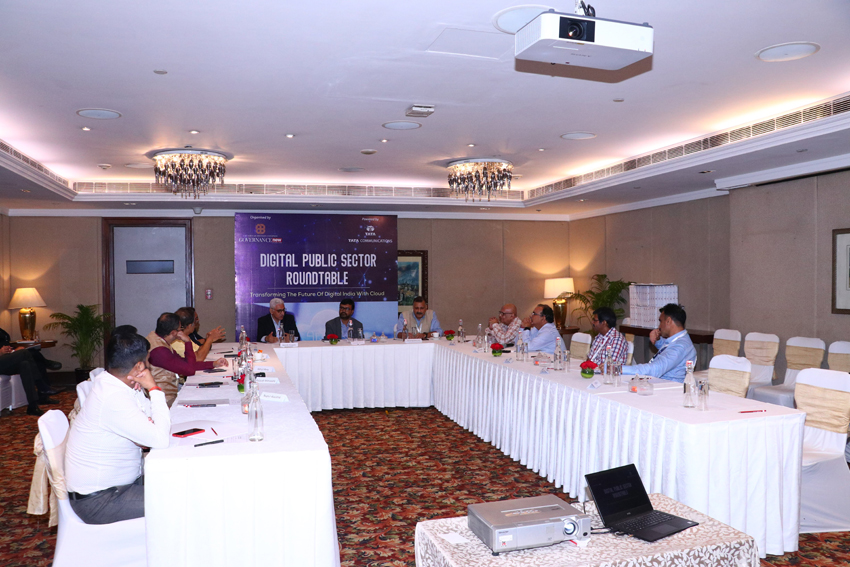|

Digital Public Sector Roundtable
POWERING THE FUTURE OF DIGITAL INDIA WITH GOVERNMENT COMMUNITY CLOUD
India is undergoing a remarkable transformation towards an inclusive, secure, and digitally advanced economy, and cloud computing is playing a vital role in bridging the digital divide. The Digital India Mission has revolutionized the delivery of government services to millions of people across the nation. As this pioneering campaign enters its next phase, it aims to meet the expectations of an increasingly tech-savvy population by ensuring seamless access to citizen services anytime and anywhere. To tackle this challenge, government enterprises must adopt a fresh approach to digitization.
Every organization is charting its unique path towards a digital future. While digitization brings about new risks and uncertainties, it does not mean compromising on security. The growing reliance on digital technology in day-to-day public sector operations exposes organizations to greater vulnerabilities such as data breaches, ransomware attacks, and cyber intrusions. As more applications migrate to the cloud, users, data, applications, and traffic extend beyond the protected corporate perimeter.
The advent of a cloud-first and internet-dependent world has introduced new risks to enterprises. Cloud and multi-cloud practices are increasingly adopted by public sector organizations. Therefore, it is crucial to empower these organizations to secure multi-cloud environments and effectively manage vulnerabilities that arise in these new landscapes, albeit with varying levels of success. In recent years, organizations have employed various technologies to enhance their security posture, adopting a multi-layered defense strategy to combat evolving cyber threats. Security leaders recognize the utmost importance of cybersecurity and strive to safeguard their assets and networks against prevalent cyber-attacks. However, the question remains: how can they accomplish this?
Given the significant role that cloud technology plays in the digital journey of government enterprises, ensuring cybersecurity and data privacy becomes paramount in protecting customer data from breaches. With multiple integrations and technologies on cloud platforms, and the increasing sophistication of cloud-based threats, hackers can exploit vulnerabilities arising from misconfigurations, weak or unauthorized access, or malicious insiders. These breaches can compromise security controls, establish footholds, and move laterally to extract sensitive data. Frequently, vulnerabilities in applications or infrastructure are exploited to gain access to customer data, therefore, it is of utmost importance that the design, deployment, and compliance of any cloud infrastructure hosting government applications prioritize the highest standards and be certified by a competent authority. Cloud service providers should ensure the sovereignty of data, allowing the Government of India to maintain control and visibility over applications and data.
Key Discussion Pointers
- How does the hybrid model provide government ministries with enhanced control and visibility over their data in the cloud, combining the scalability of a cloud environment with the performance and compliance of a dedicated private cloud?
- How does the Sovereign Cloud Platform ensure the integration of a hybrid-ready cloud platform that offers customers the desired flexibility and control? Furthermore, how does this platform ensure compliance with evolving regional and regulatory guidelines, while also guaranteeing that foreign authorities have no access to the data?
- With rising internal attacks from malicious insiders or compromised credentials, escalate security with SSO, MFA and privilege identity management to stop abuse from privileges, and attacks on admin accounts.
- Assessing the risks and benefits of cloud technology in the context of data privacy, security, and regulatory compliance
- Implementing robust cybersecurity measures to protect sensitive public sector data in the cloud
- Ensuring compliance with government regulations and data protection laws
- Building a risk-aware culture that emphasizes cybersecurity awareness and best practices
- How can organizations ensure the effectiveness of their risk management strategies in the context of cloud adoption by conducting regular risk assessments and audits? Furthermore, how do these assessments and audits help identify and address potential vulnerabilities to maintain a secure cloud environment?
- Developing incident response plans and business continuity strategies to mitigate cybersecurity incidents
- Continuously monitoring and evaluating cloud deployments to maintain compliance, security, and innovation.
glimpses

|